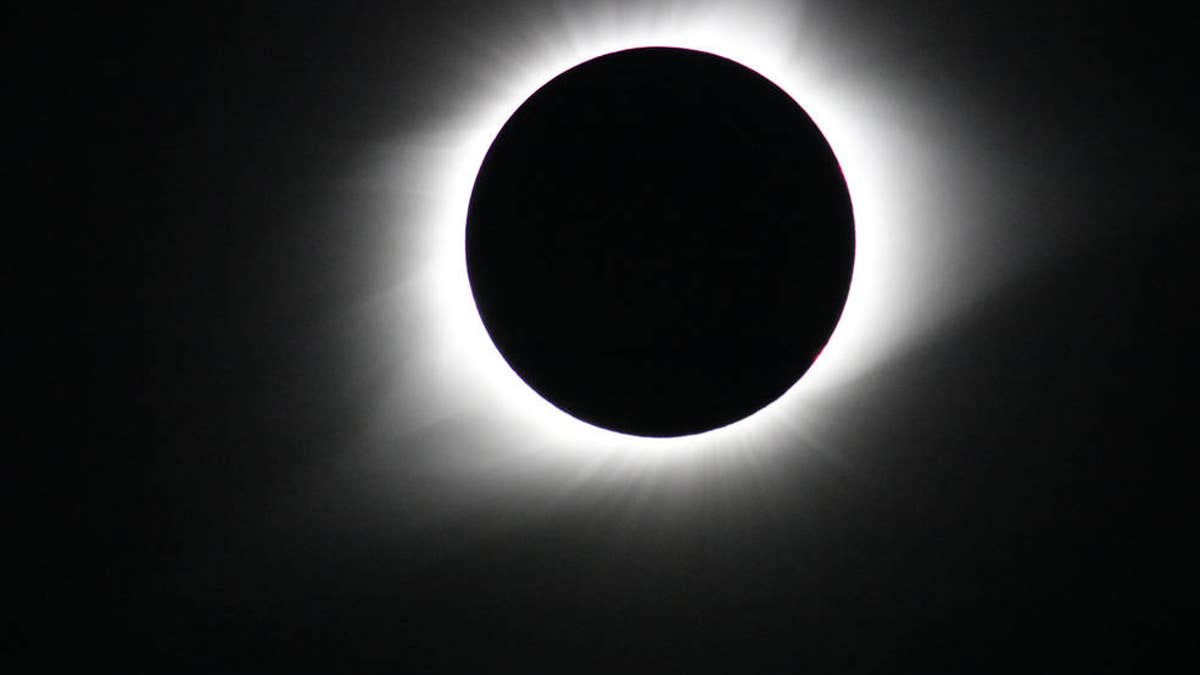Solar Eclipse 2017: Best images across America
The Great American Eclipse finally arrived and did not disappoint. Here are the best images from the big event
A swath of South America is set to enjoy a total solar eclipse.
The July 2 solar eclipse will plunge part of the continent into darkness, with the line of totality stretching across areas of Chile and Argentina. Weather permitting, a partial eclipse will also be visible in some places in Ecuador, Brazil, Paraguay and Uruguay, according to timeanddate.com.
A solar eclipse occurs when the Moon passes between the Earth and the Sun and scores a bull's-eye by completely blotting out the sunlight.
SOLAR ECLIPSE 2017 IN PICTURES
Tourists from around the world are expected to flock to the line of totality to witness the unusual event.
The line of totality also passes within a mile of the site for the planned Giant Magellan Telescope at La Serena, on the edge of the Atacama Desert in Chile.
“We are very much looking forward to seeing the total solar eclipse in July,” said Patrick McCarthy, astronomer and vice president of the Giant Magellan Telescope, in a statement emailed to Fox News. “We will also enjoy the spectacular Chilean night sky and get a first-hand look at the progress of construction at the GMT site. It promises to be a great week.”
SOLAR ECLIPSE: THE BIG EVENT IS FINALLY HERE
The powerful 1,500-ton Giant Magellan Telescope, which is expected to be operational in 2025, aims to expand our understanding of the universe.

A photo taken during the total solar eclipse on Aug. 2017. (NASA/Gopalswamy)
The full eclipse begins in the South Pacific at 2:01:08 p.m. EDT and, after crossing Chile and Argentina, ends at 4:44:46 p.m. EDT, according to timeanddate.com.
Many Americans, of course, will fondly remember the solar eclipse of 2017, which captivated millions of people across the country.
WHAT CAUSES A TOTAL SOLAR ECLIPSE?
The coast-to-coast eclipse on Aug. 21 of that year carved a 70-mile wide path of totality from the Pacific coast to the Atlantic, with hordes of people donning solar eclipse glasses to experience the unusual event. The eclipse, which began in Oregon and ended in South Carolina, was the first to cross the continental U.S. since 1918.

People look at a total solar eclipse on Svalbard on March 20, 2015. (REUTERS/Haakon Mosvold Larsen/NTB scanpix)
Families from all over the country flocked to cities in the line of totality, such as Charleston and Nashville, which hosted over 1 million visitors.
The Giant Magellan Telescope’s McCarthy told Fox News that he was in Oregon for the 2017 eclipse. “Words cannot describe the unique sensation of totality,” he explained, via email.
WHAT CAUSES A TOTAL SOLAR ECLIPSE?
The next total solar eclipse in the U.S. will be in 2024 and the next coast-to-coast one won't be until 2045.

Enthusiasts from Vacaville, Calif., watch a total solar eclipse at Painted Hills, near Mitchell, Ore., on Aug. 21, 2017. (REUTERS/Adrees Latif)
NASA will be closely monitoring the July 2 total eclipse in South America. “Studying the Sun during total solar eclipses helps scientists understand the source and behavior of solar radiation that drives space weather near Earth, which can affect the health of astronauts in space and the durability of materials used to build spacecraft,” it explains NASA, on its website. “Similar data will be important in planning NASA’s return of astronauts to the Moon in 2024 and eventual crewed missions to Mars.”
The space agency will be live-streaming the total solar eclipse with the Exploratorium in San Francisco. NASA will also be providing updates from its Parker Solar Probe.
NASA'S PARKER SOLAR PROBE BLASTS OFF ON EPIC JOURNEY TO 'TOUCH THE SUN'
The Probe blasted off from Cape Canaveral Air Force Station atop a United Launch Alliance Delta IV Heavy rocket on Aug. 12, 2018. The $1.5 billion mission is taking humanity closer to the Sun than ever before.

In this multiple exposure photograph, the phases of a partial solar eclipse are seen over the Gateway Arch on Monday, Aug. 21, 2017, in St. Louis. The Gateway Arch was just a few miles outside of the path of totality. (AP Photo/Jeff Roberson)
In October 2018, the Probe clinched the record for closest approach to the Sun by a man-made object. In April 2019, Parker completed its second close approach, coming within 15 million miles of the star.
On its closest approach in 2024, the probe will come within 3.8 million miles of the Sun’s surface. It will also be traveling at approximately 430,000 mph, setting a new speed record for a manmade object.
NASA’S PARKER SOLAR PROBE BREAKS RECORD, BECOMES CLOSEST SPACECRAFT TO THE SUN

ESA's Proba-2 satellite experienced 3 partial solar eclipses during the total solar eclipse of Nov. 13, 2012 (EST). This image is taken from a video made by the spacecraft. (ESA)
Other spacecraft will also be monitoring the July 2 eclipse in South America. In addition to the Parker Solar Probe, NASA will be providing updates from its Magnetospheric Multiscale (MMS) mission, which uses four spacecraft in near-Earth orbit to study the area of space dominated by our planet’s magnetic field.
CLICK HERE TO GET THE FOX NEWS APP
Another total solar eclipse will be visible in South America on Dec. 14, 2020.
The Associated Press and Fox News’ Chris Ciaccia contributed to this article. Follow James Rogers on Twitter @jamesjrogers

